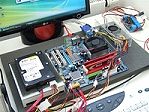DIY Solar-Powered PC: Solar Components
Battery Operation: 14 Nighttime Hours
The other 14 hours during which the solar cells deliver no power must be serviced by energy stored in the battery. This means a discharge of 855 Wh (14 hours x 61 Watts = 854 Wh, rounded to 855).
Because we must also factor a 20% energy loss from battery use into this equation, we require that the battery must store 1030 Wh (855 Wh + 20% = 1026 Wh).
Adding the daytime energy consumption to the nighttime consumption we come up with a total daily energy budget of 1636 Wh (610 Wh by day + 1030 Wh by night = 1636 Wh total).
The battery at work in our test installation
Together our two solar panels must deliver an average of 163 Watts during the day so that the PC is able to operate 24 hours a day. If we fail to attain this value, the PC will shut down in the middle of the night when it runs out of power.
Each solar cell produces 130 Watt under optimal conditions. Thus, our solar power rig must produce at least 62.9% of that value for at least 10 hours a day, to keep it running around the clock.
Solar Battery Energy Capacity: 1592 Wh
Because the solar cells experience regular voltage sags daily, primarily because of cloud cover diminishing or interrupting power collection, the battery also acts as a buffer to provide reserve energy when needed.
Get Tom's Hardware's best news and in-depth reviews, straight to your inbox.
If our solar cells operate at 100% of their capability for 10 hours a day, with no clouds to interfere with collection, we can collect an additional 1990 Wh per day above and beyond what the PC consumes (10 hours x (260 Watts - 61 Watts for PC) = 1990 Wh) for storage.
After factoring out the 20% power loss from the battery itself, this produces a usable capacity of 1592 Wh. This means our battery, which has a rated capacity of
1560 Wh is perfectly sized to handle excess collection without losing appreciable energy.
But of course, these are gross totals, which fail to take power losses from other components into account.
A fuse on the battery protects components from short circuits.
Smaller fuses provide additional protection.
Because a lead acid battery of this capacity can produce extreme power spikes, we must protect all attached devices with fuses.
A wall-socket is a no-no for this PC: our first attempt at computing independent from the power grid.
Current page: Battery Operation: 14 Nighttime Hours
Prev Page 1.5 KWh Storage Battery Next Page Shopping List: Components And Prices


